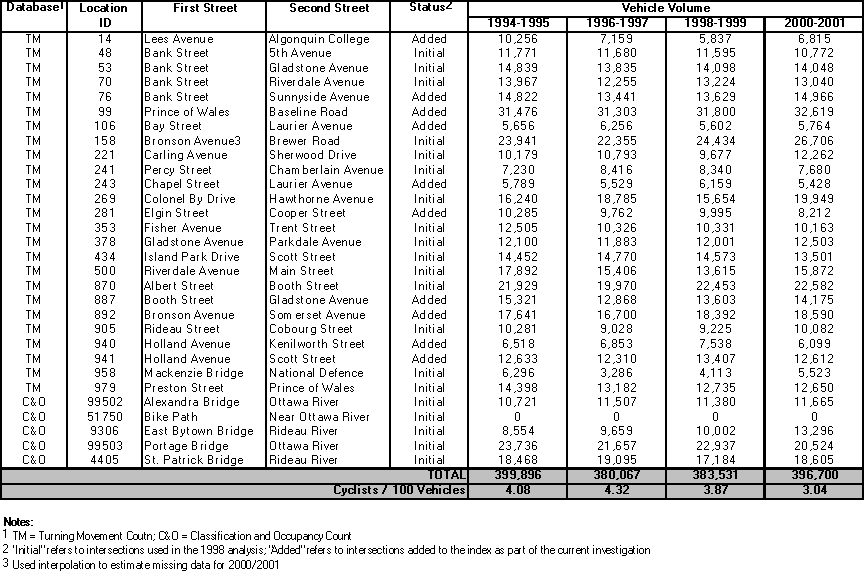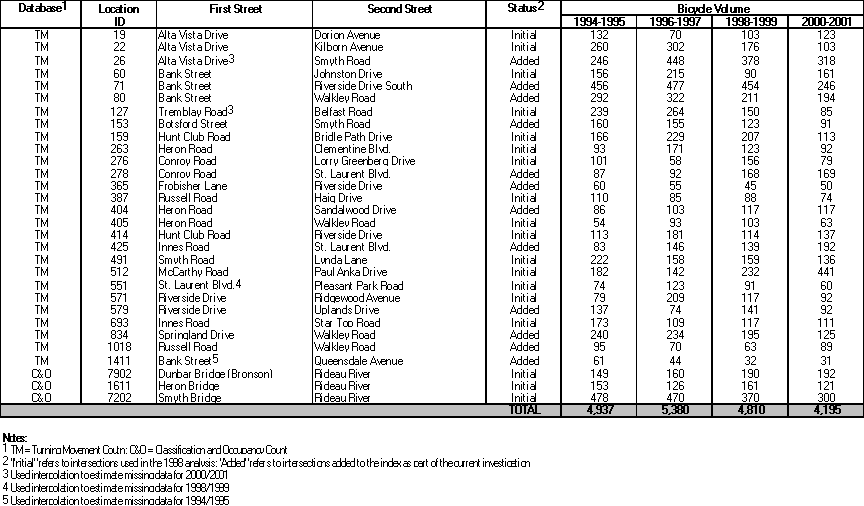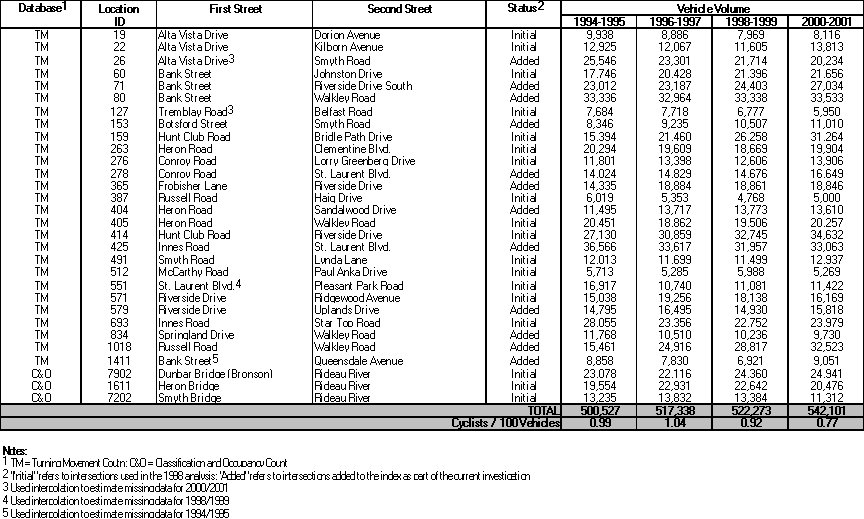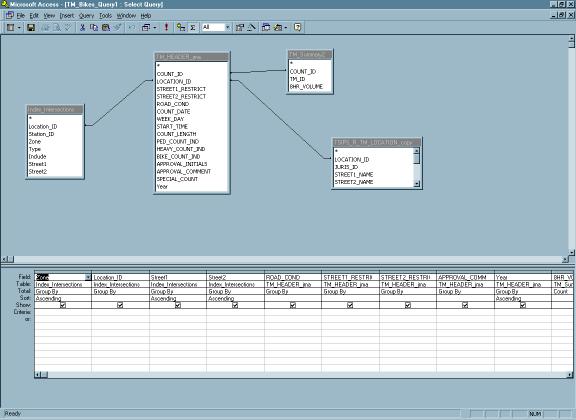Results of Literature Review / Phone Interviews: Monitoring
Cycling Activity
|
Description
|
Vancouver
|
Calgary
|
Halifax
|
Windsor
|
Toronto
|
Waterloo
|
Portland
|
Boston
|
|
|
P
(1998)
|
P(1)
(2000, 1992)
|
P
(electronic survey – 1999)
|
· Not known
|
P
(1999 – plan to repeat every 3 years)
|
P
(2002 – survey is unlikely to be repeated in future)
|
P
(2000)
|
|
|
Bicycle counts at selected
locations (used for monitoring trends over time)
|
O(4)
(recently started conducting automatic cycling
counts; insufficient data to establish historical trends)
|
O
|
P
(bridge over harbour – annual count)
|
O
|
P
(have used permanent count stations in the past but
there are none currently in operation; plan to install more at key locations)
|
|
P
(annual counts at main bicycle bridges)
|
P
(periodic counts at selected locations between 1975
and 1997)
|
|
“Before and After” studies
|
P
(required as part of cost-sharing arrangement with
provincial government)
|
O
|
O
|
O
|
P
|
|
|
|
|
|
P
|
P
|
O
|
P
(just started counting cyclists in 2001)
|
P
|
|
|
|
|
Turning movement count data
used to monitor cycling activity
|
P(2)
|
O
(requested data once, but data format was not
user-friendly)
|
O
|
O
(not enough years of data)
|
O
(volumes not considered reliable at busy
intersections)
|
|
|
|
|
Conduct screenline counts
with cyclist volumes
|
P
|
P
|
O
|
P
(count locations have little cycling activity)
|
P
|
|
|
|
|
Screenline count data used
to monitor cycling activity
|
P(3)
(central area cordon)
|
P
(downtown)
|
O
(hope to begin doing this)
|
O
|
P
(central area cordon – weather impacts reliability
of results)
|
|
|
|
|
Household travel survey
|
P
(census data, trip diary survey every 5 years –
sample size too small to be statistically reliable at the sub-area level,
except downtown)
|
P
(walking and cycling treated as one mode; conducted
every 3 to 4 years?)
|
· Information not provided
|
P
|
P
(participate in the Transportation Tomorrow Survey,
conducted every 5 years)
|
P
(last participated in the Transportation Tomorrow
Survey in 1996, will likely participate again in 2006)
|
P
(1994 survey,
census data)
|
P
(1991)
|
|
Other monitoring activity
|
· N/A
|
· Pathwatch
– counts on recreational
paths, inc. weekend and night counts. Last counts were in 1994; currently
conducting new counts. Plan to tie results into GIS. Data used to prioritize
projects and justify funding.
|
· N/A
|
· Parks people occasionally conduct counts on
waterfront trails (last count was approx. 2 years ago)
|
· N/A
|
· Conduct employee surveys at employers involved in
TDM programs
· Currently developing a TDM school curriculum which
has opportunities for monitoring travel activity (school audit, family audit)
· Also working with community groups such as “Active
& Safe Routes to School” which may have monitoring opportunities
|
|
|
|
Mode share targets
|
· Downtown, University of BC, city-wide
|
· CBD and city-wide
|
· Information not provided
|
· Do not have cycling
mode share targets
|
· Mode share targets exist – no details provided
|
· Mode share targets exist – no details provided
|
· Inner city and city-wide
|
|
|
Other comments
|
· Do not use traffic count data to monitor OP targets,
only O-D data from household surveys
|
· No monitoring on a year-by-year basis
· Would like to monitor cycling activity, but lack of
staff continuity hinders efforts
· Additional monitoring would likely focus on
“generators” and high-use areas
· Have looked at using automatic counters but there
are problems with reliability
· Identified need for winter counts to justify winter
maintenance on paths
|
· “Don’t monitor pedestrian and cycling activity”
|
· Turning movement counts are “only source” of bicycle
activity data that is currently collected
· Just beginning to implement cycling improvements (no
need to monitor activity until recently)
· Will be hiring a bicycle coordinator in the near
future who will be responsible for developing a program for monitoring
cycling activity
|
·
2001 Bike Plan
recommends development of a bicycle specific data collection program – “it is
important that data be collected for peak cycling conditions and also account
for weather and seasonal fluctuations”
·
“Do not do a lot of
monitoring at present” (no formal monitoring program exists)
·
Need conversion
factors to seasonally adjust count data
|
· “Very committed and interested” in monitoring trends
· No response from traffic department regarding
traffic count program
|
· “Accurately measuring mode split for bicycling is
notoriously difficult”
· Further details on Portland’s monitoring program are
not available (no response to phone inquiries)
|
·
“Few studies provide
data estimating the number of bicyclists”
·
Did not conduct phone
interview due to limited monitoring activity evident from Bicycle Plan
|
|
Source of information
|
Vancouver Bicycle Plan, 1999
Don Klimchuk,
Transportation Monitoring Engineer
(604-873-7345)
Jim Hall,
Neighbourhood Transportation Branch
(604-873-7130)
|
Commuter
Cyclist Survey 2000: Cycling into Downtown Calgary, 2000
Scott Mackie,
Leader, Transportation Data
(403-268-5750)
Don Mulligan,
Co-ordinator, Transportation Solutions
(403-268-1652)
|
David McCusker, Manager of Traffic and Transportation Services
(902-490-6696)
|
Wes Hicks,
Manager of Transportation Planning
(519-255-6418)
|
Toronto
Bike Plan, 2001
Dan Egan, Manager of Pedestrian and Cycling Infrastructure
(416-392-9065)
|
JoAnn Woodhall, TDM Planner,
(519-575-4036)
|
Bicycle
Master Plan Five-Year Update,
2001
|
Boston
Bicycle Plan, 2001
|
(1) 1992
and 2000 surveys are not directly comparable due to the method used to
administer the survey. 2000 survey included a count of cyclists entering the
downtown during the AM peak period to compare with cordon counts (AM peak
period gives best indication of commuter travel activity). Will likely conduct
a similar survey in 5 to 10 years (will be able to compare results with 2000
survey)
(2) Data
used to examine trends on major bikeways (which generally cross at least one
signalized intersection). Data used to justify routes and track usage over time
on a route-by-route basis. Do not look at cycling trends on a sub-area basis.
Recently started to produce reports showing intersections with the highest
cycling volumes. Produced a map illustrating intersection cycling volumes for
the 1999 Bicycle Plan. The map
identifies preferred cycling routes, but is of limited value for establishing
growth rates over time.
(3) Plan
to establish a new cordon-based program to monitor cycling activity into the
downtown on a regular basis “to accurately measure the modal split for bicycles
and the effectiveness of cycling programs and initiatives”
(4) Note
that some of the “Before and After” studies of bikeways using manual traffic
counts have extended over several years
Results of Literature Review / Phone Interviews: Monitoring Pedestrian
Activity
|
Description
|
Vancouver
|
Calgary
|
Halifax
|
Windsor
|
Toronto
|
Waterloo
|
|
|
P
(street-level survey)
|
P
(street-level survey)
|
O
|
O
|
O
|
|
|
Pedestrian counts at
selected locations (used for monitoring trends over time)
|
P (2)
|
P (1)
|
P
(Bridge over harbour – annual count)
|
O
|
O
(occasionally conduct special counts to meet
specific project needs)
|
|
|
Conduct turning movement
counts with pedestrian volumes
|
P
|
P
|
O
|
P
|
O
|
|
|
Turning movement count data
used to monitor pedestrian activity
|
O
(plan to start doing so shortly using new software)
|
O
|
O
|
O
|
O
|
|
|
Conduct screenline counts
with pedestrian volumes
|
· Not known
|
P
|
O
|
· Not known
|
O
|
|
|
Screenline count data used
to monitor pedestrian activity
|
O
|
O
|
O
(hope to begin doing this)
|
O
|
O
|
|
|
|
P
(census data, trip diary survey every 5 years –
sample size too small to be statistically reliable at the sub-area level)
|
P
(walking and cycling treated as one mode; conducted
every 3 to 4 years?)
|
· Information not provided
|
P
|
P
(participate in the Transportation Tomorrow Survey,
conducted every 5 years)
|
P
(last participated in the Transportation Tomorrow
Survey in 1996, will likely participate again in 2006)
|
|
Other monitoring activity
|
· N/A
|
· Pathwatch (1994) – counts on recreational paths (not
clear if pedestrians included)
|
· N/A
|
· Parks people occasionally conduct counts on
waterfront trails (last count was approx. 2 years ago)
|
· N/A
|
· See comments under cycling
|
|
Mode share targets
|
· Downtown, University of BC, city-wide
|
· CBD and city-wide
|
· Information not provided
|
· Do not have pedestrian mode share targets
|
· Mode share targets exist – no details provided
|
· Mode share targets exist – no details provided
|
|
Other comments
|
· Have not attempted to monitor OP targets
· Pedestrian activity is typically higher on the sunny
side of the street
· Do not use traffic count data to monitor OP targets,
only O-D data from household surveys
|
· No monitoring on a year-by-year basis
· No monitoring done outside the CBD
· Accessibility of data is the key issue. People don’t
know what data is available and as a result, the data is underutilized
|
· Occasionally count pedestrians as part of specific
studies (i.e. to assess the need for a crosswalk)
|
· None
|
· None
|
· See comments under cycling
|
|
Sources of information
|
Don Klimchuk,
Transportation Monitoring Engineer
(604-873-7345)
Jim Hall,
Neighbourhood Transportation Branch
(604-873-7130)
|
Scott Mackie,
Leader, Transportation Data
(403-268-5750)
Don Mulligan,
Co-ordinator, Transportation Solutions
(403-268-1652)
|
David McCusker, Manager of Traffic and Transportation Services
(902-490-6696)
|
Wes Hicks,
Manager of Transportation Planning
(519-255-6418)
|
Dan Egan, Manager of Pedestrian and Cycling Infrastructure
(416-392-9065)
|
JoAnn Woodhall, TDM Planner,
(519-575-4036)
|
(1)
Recently surveyed 30-40 locations in the CBD. Recorded gender & age info.
Data to be used in CBD planning study and by downtown BIA. Will likely repeat
study in future with smaller sample size to keep database up-to-date. Will
likely compare results with a less comprehensive study completed 8 years ago,
however, monitoring trends over time is NOT the primary objective.
(2)
Recently re-started (and expanded) a program to count pedestrians at midblock
locations in commercial areas (mostly downtown). Locations will be counted
every 5 years (during May and June to avoid peak tourist times). 350 “block
faces” included in program. Control locations monitored to establish seasonal
and daily variations. As part of this program, the City has conducted short
opinion surveys on pedestrian travel, including OD information. Previous counts
were conducted in 1977 and 1991. Will likely compare recent data with older
data to establish trends on a street-by-street basis, aggregating data to
determine trends for the downtown area as whole
Monitoring Pedestrian and Cycling Activity in Helsinki,
Finland
E-mail Extract, October 9, 2002
We have no continuos
monitoring system for pedestrians. In the city center we arranged 1989 large
counting by using video cameras from the air( by helicopter). We made two
flights over the areas so that every part of
all the streets in the center area could be counted. In the center we
had about 40 manual counting points to get the day's hourly variation for
different types of streets. We used
coefficients for each part for every street.
If any traffic planner needs
information of pedestrian traffic in intersections, we count manually.
Our yearly calculation
system of modal split in the border of
city center does not contain at all
trips made by foot or bicycle. We count the modal split of motor vehicle trips
for the border of city center every
September.
The Metropolitan Area
Council makes origin-destination surveys about every 10 year to get the modal
split for the different cities and for trips between different areas in the
metropolitan area. In that system they take account all types of trips.
Ms. Irene Lilleberg
Helsinki City Planning
Department
Traffic Planning
Division
Address: P.O. Box 2101
FIN-00099 THE CITY OF
HELSINKI
FINLAND
Monitoring Pedestrian and Cycling Activity in Helsinki,
Finland
E-mail Extract, October 9, 2002
In Helsinki we count
bicycles with machine and manually. We have 11 counting points with machine.
Four of them we count around a year. We get data 0 am – 12 pm. Our counting
system based on Marksman. Over the bicycle road have dug loop and beside the
road is counting box. When bicyclist is driving over the loop machine
registered him. We collect data once a month and we print out results hourly
even every fifteen minutes.
In summer we also count
bicycles manually on working days from 7.00 am to 7.00 pm. Then we also count
utilization rate of bicycle helmet. Every third year we count whole Centre
boundary and Inner City boundary.
Ms. Tuija Hellman
Helsinki City Planning
Department
Traffic Planning
Division
Address: P.O. Box 2101
FIN-00099 THE CITY OF
HELSINKI
FINLAND
Monitoring Pedestrian and Cycling Activity in Helsinki,
Finland
E-mail Extract, October 16, 2002
… we use the [bicycle]
counts to determine what roads require bicycle facilities. For example Planers
use the counts for planning.
… we don't calculate
collision rates based on these counts, but we compare bicycle counts to bicycle
accidents.
… we compare machine and
also manually counting changes in different areas of the city and for one year
to the next, especially changes in summertime. Our best cycling season is from
April to September.
Our machine count
stations give us you a good idea of what's happening in the downtown area, but
also quite good idea across the entire city. Manual counts give us good idea of
what's happening across the entire city in summertime. Our machine count
stations located in downtown, beside the roads and bridges coming to downtown,
in suburban areas and in recreation areas. The machine count stations located
only on separate bicycle paths beside the roadways. Manually we sometimes also
count on roadways used by both vehicles and bicycles.
We use the machine
counts to calculate seasonal / day of week / hourly/ time
period adjustment
factors that can be applied to other count data.
Ms. Tuija Hellman
Helsinki City Planning
Department
Traffic Planning
Division
Address: P.O. Box 2101
FIN-00099 THE CITY OF
HELSINKI
FINLAND
Monitoring Pedestrian and Cycling Activity in Helsinki,
Finland
E-mail Extract, October 17, 2002
Mainly we use the
machine and manual counts to compare changes at individual count locations from
one year to the next. But every year we count bicycles in seven places at the
Centre boundary. So we know how many bicyclists are crossing the boundary
during one day and how it is changing from one year to the next. Every third
year we count more exactly Centre boundary (then 13 places) and Inner City
boundary (25 places). Then we know how many bicyclists are crossing Centre
boundary and Inner city boundary.
Ms. Tuija Hellman
Helsinki City Planning
Department
Traffic Planning
Division
Address: P.O. Box 2101
FIN-00099 THE CITY OF
HELSINKI
FINLAND
E-mail Extract from the Chair of the Transportation Research
Board Bicycling Committee, October 2, 2002
I am not aware of anyone
who does bicycle counts other than specifically for bicycle planning
issues. Including bicycles in automated
traffic counts is complicated by many factors.
The specially designed bicycle counters really only work well on
paths. I think some people use the 360
degree cameras to include bicycle counts but even then a person must manually
sit in front of the video and count. I
have talked with the Connecticut Bicycle Coalition about doing random counts at
random intersections in order to measure mode share (both the motor vehicles
and bicycles would be counted). Because
the intersections are randomly selected, given a big enough sample then some
defensible estimates could be made.
Usually bicycle counts are taken along heavily used routes which skews
mode share estimates.
Lisa Aultman-Hall, Ph.D.
Associate Professor
Department of Civil and
Environmental Engineering
261 Glenbrook Road, Unit
2037
University of
Connecticut
Storrs, CT
Results of Literature Review - General Comments
·
Although there is a general desire to monitor
pedestrian and cycling activity, in practice, few cities do so due to a lack of
data (Bicycle and Pedestrian Data:
Sources, Needs, & Gaps, U.S. DOT, 2000)
·
Monitoring is often limited to before and after counts
on a particular facility (limited usefulness for monitoring region-wide trends,
as an increase in activity on one route may not reflect an increase in the
number of cycling trips)
·
Some cities use counts on existing cycling facilities
to estimate demand on other facilities (Guidebook
on Methods to Estimate Non-motorized Travel, Schwartz et al., 1999)
·
U.K. Guidelines for Monitoring Cycling Activity (DETR
1999)
-
Importance of sample size
-
Screenline approach “most practical way to monitor
cycling trends from one year to the next”
-
Random sample of bicycle counts to estimate absolute
level of cycling (can be translated into bicycle kilometers of travel)
·
U.K. Guidelines for Monitoring Pedestrian Activity
(DETR 2000)
-
Choose sites with high levels of walking activity, near
major generators









